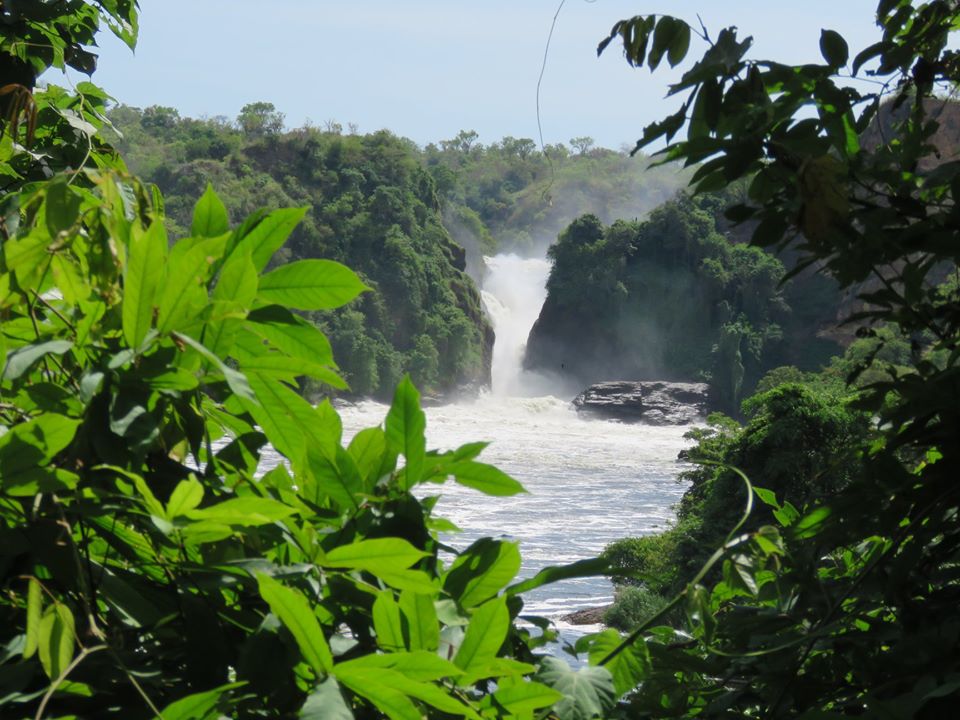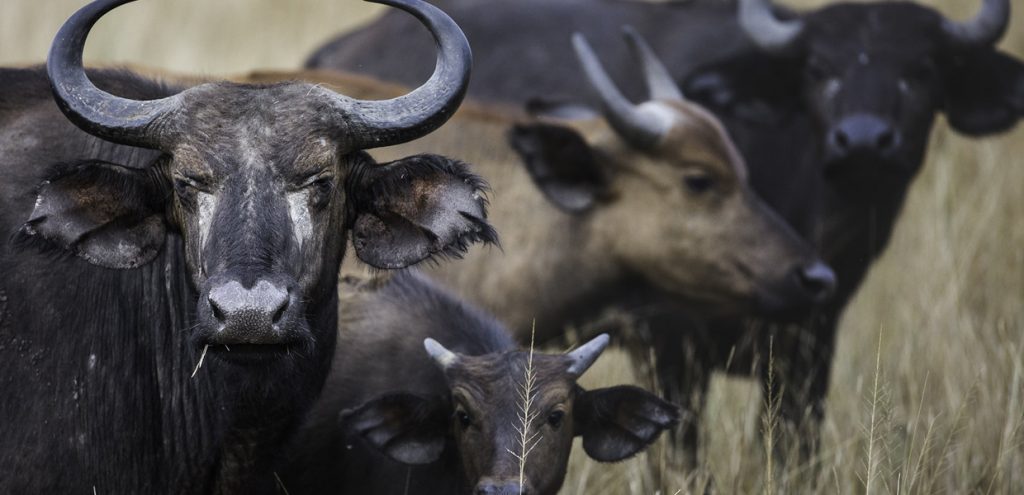One of the key facts about Murchison Falls National Park (MFNP) is that it is the largest and oldest conservation area in Uganda that lies at the northern end of the Albertine Rift Valley, in north-western Uganda. This is where the sweeping Bunyoro escarpment tumbles into vast, palm-dotted savanna.
Murchison Falls National Park was first gazetted as a game reserve in 1926, and later elevated to a national park status in 1952.

More about Murchison Falls National Park.
The park covers 3,840 sqkm of land, spreading inland from the shores of Lake Albert on the western side, along the Victoria Nile, up to the Karuma falls on the eastern side. Together with the adjacent 748 square kilometres (289 sqmi) Bugungu Wildlife Reserve and the 720 square kilometres (280 sq mi) Karuma Wildlife Reserve, the park forms the Murchison Falls Conservation Area (MFCA).
Murchison Falls National Park is bisected by the Victoria Nile from the east to the west, for a distance of about 115 kilometers (71 miles). Here, the waters of the Nile river flow through a narrow gorge which is only 7 meters (23 feet) wide. This then plunges 43 meters (141 feet) down, forming what is termed as ‘the world’s most powerful waterfall’.
Being the biggest nature reserve, its impressive animal populations and superb tourist activities, augmented by its location, make Murchison Falls National Park a popular destination in Uganda. The park straddles the Victoria Nile as it makes its way through multiple rapids and waterfalls, including the enormously impressive Murchison Falls, before reaching Lake Albert.
This is an exceptional place to see a variety of wildlife, so a boat trip along the Nile should not be missed. Do not forget the simply unforgettable experience of seeing the powerful Murchison Falls up close and personal.
Location of Murchison Falls.
Murchison Falls National Park is located in the north-western side of Uganda, occupying the districts of Buliisa, Nwoya, Kiryandongo, and Masindi. The driving distance from Masindi, the nearest town, to the Kibanda area of the park is about 72 kilometres (45 mi). This area is about 283 kilometres (176 mi) by road, from Kampala, the capital of Uganda.
The coordinates of the park near the Kibanda area are 02°11’15.0″N, 31°46’53.0″E , that is at latitude: 2.187499, and longitude: 31.781400.
Murchison Falls is adjacent to the Masindi-Gulu highway, just off at the Karuma Falls. Here’s the location of the 600 megawatt Karuma Power Station, which is currently Uganda’s largest power station.
History of Murchison Falls.
Murchison Falls is the name that was given to the point at which the world’s longest river, river Nile, is channeled through a narrow gorge within the Rift Valley, descending almost 50 metres below.
1860s – 1920s
Sir Roderick Murchison (1792–1871), was the president of the Royal Geographical Society, which was the catalyst for many explorations within the ‘colonial Africa’. Most notably, was the search for the source of the river Nile.
The explorers John Speke and James Grant were the first Europeans to visit the present day Murchison Falls Conservation Area in 1862. It was more thoroughly explored by Sir Samuel and Florence Baker in 1863-1864. Baker named the falls ‘Murchison’ after the geologist Roderick Murchison, then the president of the Royal Geographical Society.
Between 1907 and 1912, the inhabitants of an area of about 13,000 square kilometres (5,000 sq mi) were evacuated due to sleeping sickness spread by tse-tse flies. This paved the way for the establishment of the Bunyoro Game Reserve in 1910, which encompassed roughly the area south of the Nile River that is in Masindi district, now part of Murchison Falls National Park.
1920s – 1950s
In 1928 the boundaries were extended into Gulu district north of the river, and the resulting protected area became known as the Bunyoro-Gulu Game Reserve. That area roughly contributes part of the the park that is in the districts of Buliisa, Masindi, and Kiryandongo. In 1928, the boundaries were extended north of the river into the modern-day Nwoya district.
Since the human population had already been evacuated due to sleeping sickness, it was easier to establish this game reserve without displacing any of the local people.
In 1932, the Budongo Forest Reserve was established, and it became the first commercial logging concession in Uganda. To date, it is one of the most intensively studied ‘working’ forests in the world.
The boundaries of this forest continued to expand over the next thirty years until they reached the current size of 825 sqkm. Much animosity was created by this process and locals lost land because they never quite knew where the boundaries were, due to the frequent changes.
In 1952, the British administration established the National Parks Act of Uganda. The area described above became Murchison Falls National Park.
1960s – To date
After forty years of reduced hunting in the Bunyoro-Gulu Game Reserve, the animal populations had expanded to an extent that justified upgrading the reserve. This became Murchison Falls National Park, one of the first two national parks, along with Queen Elizabeth National Park.
By the mid-1960’s, Murchison Falls had become the premier safari destination in all of East Africa, with over 60,000 visitors per year.
The park was previously referred to as Kabalega National Park, named after Kabalega the Omukama of Bunyoro Kingdom, during the end of the 19th century. Kabalega resisted colonization by the British, was arrested and exiled by the British to the Seychelles island. Kabalega died in Jinja, in 1923 en-route to Bunyoro from exile.
The name of the falls was reverted back to Murchison Falls following the downfall of Idi Amin, however, it is still sometimes referred to as ‘Kabalega Falls’.
Wildlife in Murchison Falls National Park

Murchison Falls National Park is the only national park in Uganda where all the ‘five big game’ can be spotted. That is, buffaloes, elephants, lions, and leopards – which are best seen in the northern section beyond the Victoria Nile.
Rhinos were sadly extinguished because of poaching, but are now being bred again and rehabilitated in Ziwa Rhino Sanctuary. This is south of the park where between 40 to 50 rhinos are planned to be released into the wild in approximately 30 years.
Wildlife populations have largely recovered from poaching that heightened during president Idi Amin’s era till late 1980s.
Rhino breeding has since been resumed and are being conserved at Ziwa Rhino Sanctuary in Nakasongola en-route to Murchison Falls. These are expected to be re-introduced in the park once there is a good number of rhinos bred.
Murchison Falls National Park is one of the most famously visited national parks in Uganda. This is joined with Bugungu and Karuma wildlife reserves to make up the Murchison Falls Conservation Area.
The park is endowed with a good number of wildlife species and several attractions. These include over 76 mammal species with four members of the big five. Other species include bushbucks, Uganda kobs, waterbucks, warthogs, Rothschild’s giraffes, duikers, Bohor reedbucks, oribis, warthogs, Jackson’s hartebeests, and hyenas among others.
Other wildlife specie and activities
Apart from the big five, there are also primates in the park including chimpanzees, baboons, and vervet monkeys among others. These are found in the Budongo Forest, which is in the southern part of the park.
Along the shores of the Nile and within the waters, you will see lots of hippos and crocodiles among other resident creatures.
There are more than 450 bird species in Murchison Falls ranging from common to a variety of water birds. These include the rare shoebill stork, Bugondo’s 59 restricted range species, dwarf kingfisher, Goliath herons, white-thighed hornbill, Egyptian goose, abyssian ground hornbill, black belly bustard and great blue turaco among others.
A variety of water-associated birds are prolific along the Nile river, while raptors make a strong presence on the checklist with 53 species recorded. The park is also home to 23 Albertine rift endemics given its location in the western arm of the east African rift valley.
Other parks in Uganda with highest concentration of wildlife in Uganda include Queen Elizabeth National Park. This is famous for the tree-climbing lions in the southern Ishasha section and a boat cruise along Kazinga channel that joins Lake George and Edward. This harbors a wide variety of aquatic life.
Kidepo Valley National Park is also another suitable place for the best wildlife safaris in Uganda. The 540 sqmi park contains diverse landscape, from lush mountain ranges to vast plains, and is home to almost 500 bird species and 77 different mammals.
In Rwanda, Akagera National Park is a beautiful place to enjoy a wildlife safari in Rwanda. Viewing game animals and beautiful birds. There are probably not as many animals as game reserves in Uganda but it’s still a very beautiful place to visit while in Rwanda.
